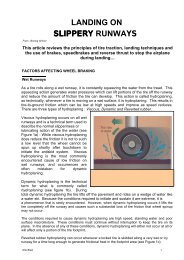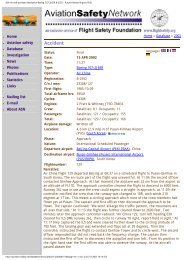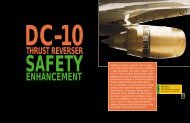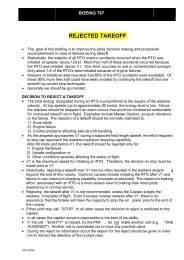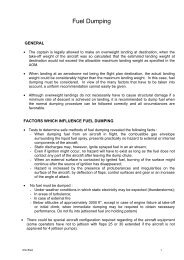Boeing 737-236 series 1, G-BGJL: Main document - Leonardo
Boeing 737-236 series 1, G-BGJL: Main document - Leonardo
Boeing 737-236 series 1, G-BGJL: Main document - Leonardo
You also want an ePaper? Increase the reach of your titles
YUMPU automatically turns print PDFs into web optimized ePapers that Google loves.
several small areas where the fire beneath theseats had been more severe than that above them.<br />
(Appendix 8 Figc).<br />
The upper halves of the forward entrance vestibules were sootedand, above chest height, the plastic<br />
decorative surfaces had partiallyburnt away. In contrast, the lower halves were free of<br />
significantsoot deposits and there were no indications of heat damage. Therear vestibule was more<br />
severely damaged, but the fire's attackwas mainly evident above waist level and was more<br />
pronounced onthe right side of the aircraft, adjacent to the door aperture:there was relatively little<br />
heat damage close to the floor.<br />
The upper halves of each toilet compartment and the flight deckwere heavily sooted and there were<br />
thick layers of oily soot onall horizontal surfaces, but each of these zones was free of heatdamage.<br />
There was no significant fire damage aft of the rear entrancevestibule nor below cabin floor level<br />
forward of the rear cargohold.<br />
The damage affecting the centre and forward sections of the cabinwas consistent with a fire burning<br />
internally within the passengercompartment, whereas the damage to the aft fuselage was<br />
consistentwith a combination of external and internal fire.<br />
The fire damage to the cabin interior as a whole did not fallinto any single overall pattern, but it did<br />
reflect the generalseverity of damage to the adjacent structure, upon which was<br />
superimposedadditional damage produced by burning overhead debris fallingdown onto the seats.<br />
Pockets of severe, isolated damage were presentat several locations, but there was no direct<br />
evidence as to theircause.<br />
Window panels<br />
All three panels were missing from most of the window aperturesin the rear cabin; some panels had<br />
remained in position in thethree apertures immediately forward of the L2 door and the<br />
partiallyburnt remains of all three panels were still present in the apertureimmediately forward of<br />
the R2 door. In the centre and forwardsections of the cabin most window apertures had one or more<br />
panelspresent. All of the surviving outer window panels aft of the overwingexits displayed a cubic<br />
cracking pattern on their outer surfacesconsistent with heating of the panel from outside. Forward<br />
ofthe overwing exits, many of the outer panels displayed similardamage but with the cracking on<br />
the inner surfaces - consistentwith heating from inside the cabin.<br />
Examination of the window panels indicated that the followingexternal fire penetration mechanism<br />
had occurred:-<br />
a) outer panels - extreme local shrinkage of the outer (heated)surface producing a deep cubic<br />
cracking pattern of the affectedsurface together with overall shrinkage and thickening of thepanel,<br />
causing it to pull out of the retaining clips and fallout of the aperture.<br />
b) centre panels - softening and bulging of the panel. The lossof the outer panel removed clamping<br />
pressure from the centre panel,allowing the centre panel to come out of its securing clips andfall<br />
out of the aperture.<br />
c) The inner (anti-scratch) panels melted down and burnt.<br />
The window apertures in which there were no panels remaining displayedwidely differing degrees<br />
of heat damage and sooting in the areasnormally protected by the silicone rubber window seals,<br />
givingan indication of the stage in the fire when the window panelsbecame detached. Generally, the



